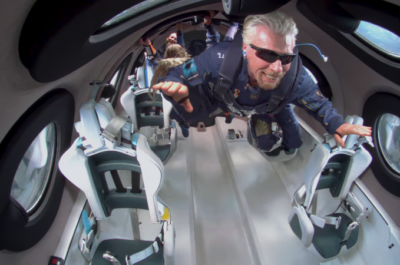The space tourism market expanded at 18.6% CAGR from 2018 to 2022. For the projection period (2023 to 2033), the market is set to progress at 38.6% CAGR.
The global space tourism market revenue is expected to reach US$ 678.3 million at the end of 2023. Overall space tourism demand is likely to rise at an impressive 38.6% CAGR through 2033. The space tourism industry is projected to reach around US$ 13,239.5 million in 2033.
- Rising popularity of space tourism worldwide is driving the global market forward.
- Development of next-generation space technologies to boost market
- Reduction in space tour prices will elevate demand
- Growing popularity of online booking will bode well for the market
- Increasing government initiatives and investments to develop space tourism to trigger sales
- Popularity of orbital and suborbital vehicles to create growth prospects
Space tourism refers to practice of traveling into space, particularly for recreational and leisure purposes. It is a niche segment of aviation industry. Space tourism allows common people to become astronauts and experience space travel for business, leisure, or recreational purposes.
Orbital space tourism, lunar space tourism, and suborbital space tourism are a few types of space tourism. Increasing inclination towards opting for space tours to get new experiences of space will boost the market.
Currently, space tourism is very expensive and only a small segment of consumers are able and willing to get this space experience. However, advancements in space technologies are gradually changing this.
It is expected that development of new space technologies that will reduce space tour and trip prices will boost the global space tourism industry during the projection period. Over the next ten years, more and more people belonging to middle class will opt for space tours. This will generate lucrative revenues for space tourism companies.
Another key factor that will propel space tourism demand is the development of new commercial destinations in space. Several governments and space agencies are putting efforts to build commercial space stations or destinations. These destinations or stations will be available to both private sector and government customers. This will bode well for the market.
Companies such as SpaceX, Blue Origin, and Virgin Galactic are blazing their paths into space tourism. They are spending huge amounts on research and development activities, experiments, and space technology testing.
2018 to 2022 Space Tourism Market Outlook Compared to 2023 to 2033 Forecast
As per FMI, the space tourism market expanded at 18.6% CAGR from 2018 to 2022. For the projection period (2023 to 2033), the market is set to progress at 38.6% CAGR.
Growing popularity of space tourism among the middle-class population is expected to boost sales through 2033.
Strategic collaborations between direct suppliers and indirect suppliers in the industry have paved a way for innovation. Large investments are being made to develop space tourism industry worldwide.
Space tourism encourages travelers across the Earth to take experienced leisure, recreational activities, and business purposes as well. There have been technological innovations, which are contributing to the growth of the market.
There has been a significant contribution by high net-worth income individuals towards growth in the adventure travel and rise in spaceflight which is enhancing the growth of space tourism market.
Key players in the market are revitalizing the sector with research and development programs for building orbital and suborbital vehicles for traveling into space.
Sharp decline in the cost of space exploration operations will create lucrative opportunities for companies. This is due to development of the next-generation space plane.
However, with the launches of rockets, the environment is impacted in a big way. For instance, discharge of hazardous gasses is facilitating ozone layer depletion. This could act as an impediment to market expansion.
Space tourism is now expanding to be a part of adventure tourism and this is expected to develop further. Making space tourism economically affordable for the masses will help the market thrive.
The initiatives taken by the local and central governments will also boost space tourism sales between 2023 and 2033. Also, infrastructural development will positively impact the space tourism industry.
Key Trends Shaping the Space Tourism Industry
Space Transportation Shaping the Growth of Space Tourism Industry
Space transportation has been an integral part of the space industry for a long time now. There has been technological development to enable space transportation, from the standpoint of suborbital transportation, orbital transportation as well as parabolic flights.
With the sheer involvement of space agencies, and supporting private players in the space market, the industry is expected to have significant growth. For instance, there are companies such as Blue Origin and SpaceX that have launched their vehicle systems. These systems are reusable and can be used for various missions.
Advancement in the technology for space transportation will boost space tourism market. The involvement of sustainability as a growth aspect in space tourism will also impact the industry.
Rise of Hypersonic Space Travel to Positively Influence Industry
Low-cost travel space is definitely on the rise and its scope is endless. One of its key aspects is the growing popularity of hypersonic space travel, which is traveling from a certain destination to another destination with the help of aircraft.
In a reduced timeframe, these rockets can travel from one destination to another. Once the flight becomes commercially in use, there would be regular commutation between the continents. With high adoption of technology, the prices incurred in space travel are going to come down.
There is a viable possibility of space travel by its 10th generation which is going to make the future of commutation rather easy. Further, with technological advancement, this approach is actually on the verge of complete implementation.
What are the Restraints in the Growth of Space Tourism Market?
Significant Risk to Climate Incurred by Space Tourism to Restraint Market Development
There is this huge possibility that space tourism industry might lead to the depletion of ozone layer which is the base for sustaining human life on Earth. Key reason behind such occurrences is the burning of fossil fuels which absorbs light and heat from the sun, turning it into a powerful influence on climate warming.
When rockets are launched into space, they release black carbon into the stratosphere and it stays there. The Black Carbon Emissions currently stand relatively low, but when all the projections and growth will be aligned, it will bring all these threats into a real occurrence.
Country-wise Insights
Development of Next-generation Space Technologies to Boost Space Tourism in Japan
As per Future Market Insights, Japan space tourism market will expand at a stupendous pace over the next ten years. Development of new space technologies and favorable government support will boost space tourism across Japan.
The agencies involved in Japan’s space sector are planning well to align a policy formulation for Japan’s space tourism. For instance, the Ministry of Economy, Trade, and Industry (METI) has formulated various policies aligned with space promotion.
There have been various initiatives taken into strategic action as a part of the Growth Strategy Action Plan. For instance, next-generation space technology such as on-orbit commuting and optical communications is to be demonstrated and a space system will be established for monitoring the greenhouse gas effect.
Additionally, the launch of Quasi-Zenith satellite system and observation satellite, aimed towards integrated disaster prevention and advancement in management capabilities will bode well for the market.
Along with it, participation in the Mars exploration and Artemis Program set the higher goal of becoming Asia’s hub in the space business including spaceports. With these advancements in Japan’s space tourism, there will be an economical surge in the sector during the next ten years.
ISRO Developing Human Flight Capability Towards Space Tourism to Boost Market
The Indian Space Research Organization (ISRO) is striving to develop its capabilities towards space tourism by executing the demonstration of Human Flight towards Low Earth Orbit. The Indian Space Promotion and Authorization Centre (IN-SPACe) is promptly looking for active participation from the private sector to carry on with space activities which include space tourism as well.
There also has been implementation to promote, authorize, and handhold these activities from the private sector to incorporate into the space domain. Not only that but the Department of Space is undertaking the process of a space policy that is comprehensive and integrated. This will offer direction to the activities of the Private Indian Space Industry.
IN-SPACe plans on sharing the technical facilities across ISRO centers along with private entities. This will not only create dimensions of space advancement but will also bring economic benefits as space tourism evolves.
Focus of NASA and Government to Develop Commercial Destinations in Space Will Boost Sales
When it comes to space travel, the United States leads from the forefront. The country is dedicated towards developing its space tourism industry to boost its economy. Both government and space agencies such as NASA are striving to develop commercial destinations in space.
For instance, in December 2021, to make designs for space stations and other commercial destinations in space, NASA signed agreements with 3 USA companies. This includes Blue Origin of Kent, Northrop Grumman Systems Corporations of Dulles, Virginia, and Nanoracks LLC, of Houston. This will boost the United States space tourism market.
As far as transportation is concerned, NASA plans on sending two private astronaut missions on the ISS every year and further exploring these opportunities towards commercializing it for economic use further.
Strong presence of leading companies such as SpaceX will further boost the United States Space tourism market.
Competitive Landscape
Key space tour companies are employing a wide variety of strategies to dominate this market and gain profits. New space tour offers, investments in advanced technology, partnerships, acquisitions, and collaborations are few of the key strategies adopted by space tourism providers.
Tatiana is the news coordinator for TravelDailyNews Media Network (traveldailynews.gr, traveldailynews.com and traveldailynews.asia). Her role includes monitoring the hundreds of news sources of TravelDailyNews Media Network and skimming the most important according to our strategy.
She holds a Bachelor's degree in Communication & Mass Media from Panteion University of Political & Social Studies of Athens and she has been editor and editor-in-chief in various economic magazines and newspapers.




































































































































































































































